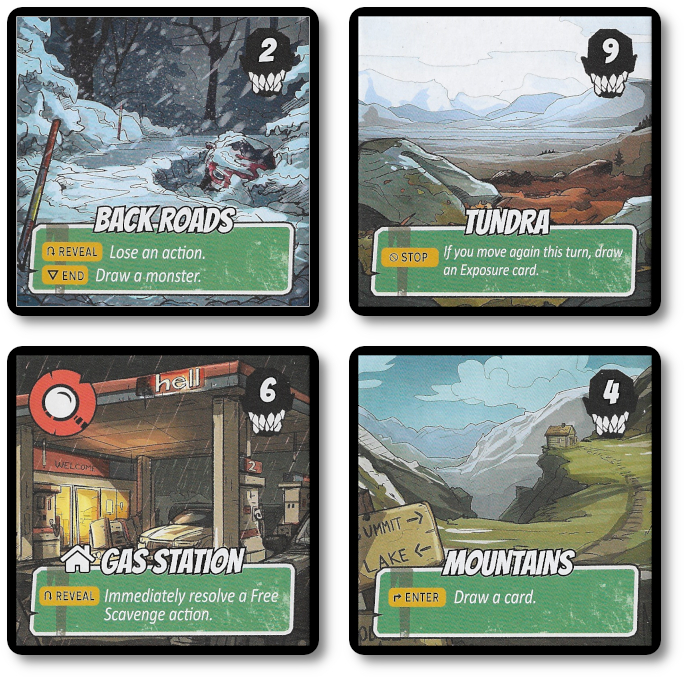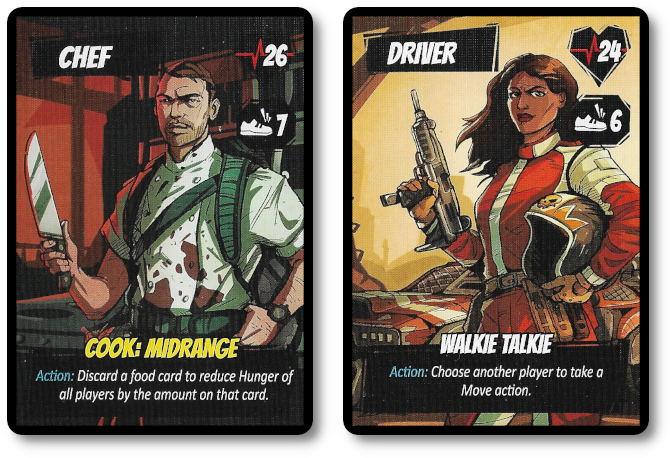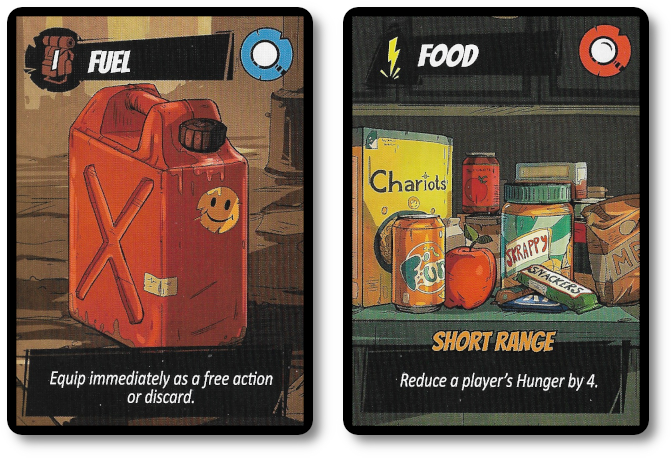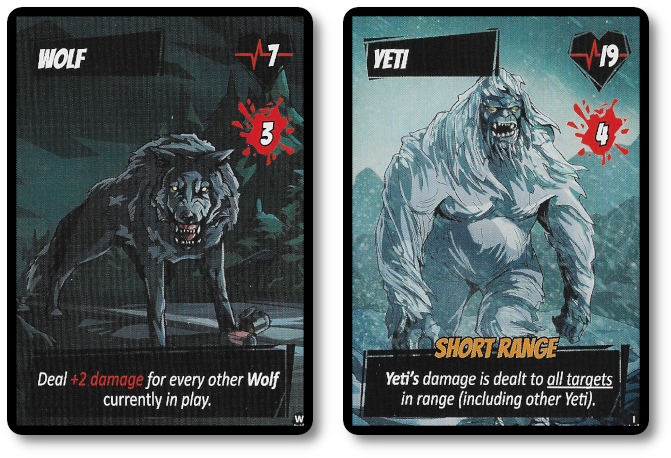 The Basics:
The Basics:
- For ages 14 and older
- For 1 to 4 players
- Approximately 60 minutes to complete
Geek Skills:
- Active Listening & Communication
- Counting & Math
- Logical & Critical Decision Making
- Reading
- Strategy & Tactics
- Risk vs. Reward
- Cooperative & Team Play
- Hand/Resource Management
Learning Curve:
- Adult- Easy
- Child – Moderate
Theme & Narrative:
- Survive as a team as you venture across an apocalyptic wild wasteland full of all kinds of nasty things
Endorsements:
- Gamer Geek approved!
- Parent Geek approved!
- Child Geek approved!
Overview
British adventurer, writer, television presenter, and businessman, Bear Grylls, said, “Survival can be summed up in three words – never give up. That’s the heart of it, really. Just keep trying.” In this game, players are survivors in a world that has turned cold, dark, and dangerous. They survive only by working together and towards a common goal, but even teamwork is not enough to guarantee success. Players must be innovative, take risks, and push to meet their objectives with the constant threat of disaster looming. Which, as it turns out, is a hell of a lot of fun!
Maximum Apocalypse: Waste Wilds, designed by Mike Gnade and published by Rock Manor Games, is comprised of 11 Survivor cards, five Survivor figures, six Health dials, 11 Survivor standees, four Reference cards, 30 Chef cards, 30 Contractor cards, 30 Driver cards, 30 Beekeeper cards, 50 Thief cards, 10 Ally cards, 139 Monster cards, 16 Dividers and Tribe cards, 54 Scavenge cards, 46 Map tiles, four Hunger dice, four Baracade tokens, 20 Day/Night cards, one Clock board, 12 Cold Exposure cards, 12 Scorched Exposure cards, 12 Pandemic Exposure cards, three storage trays, 30 Monster tokens, three Objective tokens, 12 Fuel tokens, 20 Poison tokens, 60 Hit Point tokens, three Hostility tokens, 24 Bullet tokens, two Spawn dice, two Mission Log books, and 52 Monster spawn cards. PHEW! THAT’S A LOT OF COMPONENTS! Everything fits very nicely in the box, and a packing guide is provided to ensure your game fits every time without issue. Illustrations by Gustav Rangmar are gritty, dark, and humorous. The box is full of goodness, excellent quality, and an absolute joy to play with.
Welcome to a Ruined World
Maximum Apocalypse: Wasted Wilds is scenario based. As a result, how you set up the game will vary as the game progresses. Each scenario is designed to build upon the last, meaning the components you use are introduced gradually, making not only learning the game a joy but exciting to see what new rules and challenges are presented as the game progresses.
Regardless of the scenario (referred to as “missions”) selected, each game will have a minimum setup requirement of placing the Map tiles, Clock board, and Survivors (players get to pick). In addition, the various bits will be included, such as Scavenger cards, Monster cards, and the trays of various small components that keep track of ammo, fuel, damage, and the like.
Once the game is placed per the instructions provided at the start of each scenario, the players decide who goes first and begins.
Surviving the Wasted Wilds
Maximum Apocalypse: Wasted Wilds is played in turns with no set number of turns per game. A player’s turn is structured into very simple to follow – and remember – steps. Note that some steps might not be available to the player due to the mission or the current situation being played out in the scenario.
Step One: Spawn Monsters
The players must contend with many different monsters and aggressors in the game. Each scenario in the game mixes and matches the various threats by combining different sets of Monster cards. These monsters are “spawned” into the game by rolling two six-sided dice. The resulting number is matched to any visible Map tiles. A Monster token is added if the Map tile has the same number as the rolled numbers. Note that these tokens represent the real threat the Survivors will encounter. However, until a Survivor occupies that Map tile, the danger is not defined until a Monster card is drawn, replacing the Monster token.

If a number is rolled that matches a Map tile where a Survivor is located, the Monster token is skipped. A Monster card is drawn immediately, attaching itself to the unlucky Survivor.
Step Two: Advance Time
The Clock board in the game keeps track of time, but only in the loosest of terms. Each turn moves the dial to the next position out of 12 positions. Out of these 12, only four are relevant.
- Exposure: Inflicts any Survivor out in the open with harmful conditions brought about by being exposed to the elements
- Night: Triggers events that will last throughout the game until the Clock board reaches the Day position
- Tribe Cooldown: Reduces the Tribe’s aggression and threat level towards the Survivors, but only if a Tribe is in play during the scenario
- Day: Triggers movement of Monster tokens on the Map board
Step Three: Draw a Survivor Card
Each player will take control of a Survivor. Each of the Survivors is unique, bringing a unique set of skills and gameplay to the table. The Survivor deck of cards is specific to the Survivor being played, containing actions and gear that perfectly fit with the Survivor’s background. This deck, however, is also something of a death clock. If the player runs out of Survivor cards to draw, they are out of the game.
The Survivors available in the game are as follows:
- The Driver: An ex-Stuntwoman who has the need for speed. She brings guns, ammo, and a special car that can run down the bad guys or pick up the good guys
- The Chef: Master of knives and the culinary arts, this individual knows how to keep their group well-fed and the enemy well diced
- The Thief: Stealthy and quick, the rogue is an odd one to play with, as it’s the only Survivor in the game where you want to use cards as quickly as possible, as doing so makes the Thief stronger
- The Contractor: Big and tough, this character is the warrior of the group who has a penchant for breaking things down that get in their way and building things up to stop others from getting the upper hand
- The Beekeeper: Animal lover and trainer, this character uses her animal friends as weapons and her knowledge of nature’s poisons to slow down the enemy

Survivor cards, once drawn, are placed in the player’s hand. A player’s hand size limit is ten by default.
Step Four: Take Four Actions
Each player has four actions available to them. How they use their actions is up to them. Since this is a cooperative game, players should feel free to ask for input and discuss their moves with their fellow survivors.
- Move: Movement through the Map tiles is orthogonal (up, down, left, and right). Unexplored Map tiles are flipped over and resolved as needed. Most Map tiles will have at least one task, test, or ability that the player might want to take or be forced to resolve.
- Draw a Survivor Card: If the player likes, they can add another card from their Survivor draw deck to their hand.
- Play a Card: In addition to Survivor cards from the player’s unique Survivor draw deck, they will have access to Scavenge cards that provide food, medicine, gear, and other valuable items to help the survivors throughout their journey. Cards can be played for their action, resolved, and then discarded or remain in play, equipped to the player for as long as they are helpful.
- Perform an Action: Map tiles and played cards will have actions that can be triggered. For example, using a weapon to combat a monster or searching an abandoned gas station for useful items.
- Scavenge: Some Map tiles have a Scavange icon. These represent locations where the player can take action to search and draw a Scavenge card. Caution should be taken, however, as sometimes searching draws the attention of monsters, resulting in an ambush.
- Parlay, Trade, or Reinforce: Depending on the mission, a player could try to make friends with a Tribe, trade with them, or work to reinforce locations.

In addition to the actions noted above, the players have access to the following free actions during their turn.
- Discard two Survivor cards to draw a new card
- Give, take, or trade Scavenge cards with another player if the Survivor figures occupy the same Map tile
- Deliver (i.e., discard out of the player’s hand) any cards needed for a mission objective at the Map tile location that requires them. For example, dropping off a tank of gas at the van.
Step Five: Monster Activation
Monster cards remain attached to the Survivor character until they are removed via combat or other means. Any Monsters still attached during this step of the player’s turn immediately do maximum damage. Players might have armor equipped or other means to reduce damage.

Step Six: Hunger and Status Effects
In this game, the players always search for food and never have enough. They become increasingly hungry as the game progresses unless food is found. Survivors starve and take damage if they go too long without food. Lucky for the survivors, there is always something to eat to hold off starvation, but you’ll have to search for it in potentially hazardous areas.
Various status effects will be triggered at this time, as well. The cold chill will take its toll on the Survivor’s health as they succumb to exposure. The same goes for poisons and other exceedingly dangerous effects on the Survivor’s well-being.

Step Seven: Check for Victory Condition
Each mission has a different victory condition, including some that influence future missions as the game progresses. If the victory condition has been met, the game is won, and the players may elect to play the next mission immediately or take it on another evening. Of course, if the victory condition has not been met, the game continues with the next player in a turn-order sequence.
Damage, Death, and Disappointment
As the game progresses, and as previously noted, players will be attacked by various creatures, aggressive people, and even monsters. Health is tracked for each of the Survivors and those they encounter. When enough damage is inflicted, death is inevitable. Survivors can only take so much damage but can also perish if the player’s deck of cards is exhausted.
If all the players lose their Survivor or there are no more Monster tokens available to place, the game is over, and the players have failed to meet the mission objective. Not to worry, however, because you can quickly reset the game and start the mission over.
To learn more about Maximum Apocolypse: Wasted Wilds, visit the game’s web page.
Final Word
 The Child Geeks had much fun with the game, but only the older group members. The game, while not overly complicated in its player’s turn execution, can feel a bit long at times, and there is a real danger of overthinking a turn. The saving grace here is that Maximum Apocolypse is a cooperative game, meaning the younger Child Geeks could always ask for help and lean on their older team members to help them think through their turns. This allowed even our youngest players to sit down and play but not necessarily understand the game fully. One Child Geek said, “I liked the game and would play it again. I love being the race car driver because she can help others by giving them a ride.” Another Child Geek said, “I thought the game was hard at first, and I didn’t understand how I was supposed to help, but my dad helped me by asking questions I could answer, and I helped us all win the mission!” When the last Survivor came home safely, the Child Geeks who played the game agreed that Maximum Apocolypse was maximum fun.
The Child Geeks had much fun with the game, but only the older group members. The game, while not overly complicated in its player’s turn execution, can feel a bit long at times, and there is a real danger of overthinking a turn. The saving grace here is that Maximum Apocolypse is a cooperative game, meaning the younger Child Geeks could always ask for help and lean on their older team members to help them think through their turns. This allowed even our youngest players to sit down and play but not necessarily understand the game fully. One Child Geek said, “I liked the game and would play it again. I love being the race car driver because she can help others by giving them a ride.” Another Child Geek said, “I thought the game was hard at first, and I didn’t understand how I was supposed to help, but my dad helped me by asking questions I could answer, and I helped us all win the mission!” When the last Survivor came home safely, the Child Geeks who played the game agreed that Maximum Apocolypse was maximum fun.
 The Parent Geeks were pleasantly surprised with the game, finding it a thoughtful and exciting cooperative that kept their attention from the very start. According to one Parent Geek, “A unique and entertaining game. I felt like I was playing a character in a movie. A movie, I must add, I would want to watch again and again. I enjoyed myself.” Another Parent Geek said, “I think the game is best with two players, but we played it with the whole family (four of us) and also had a blast. The game doesn’t take as long as you would think, and there were a lot of nail-biting moments. I don’t particularly appreciate that players who lose their survivors are out of the game. No fun for those who don’t get to play, but still a lot of fun.” When all the Survivors sat down to eat a can of old beans they found, they took a bite and found the game tasty.
The Parent Geeks were pleasantly surprised with the game, finding it a thoughtful and exciting cooperative that kept their attention from the very start. According to one Parent Geek, “A unique and entertaining game. I felt like I was playing a character in a movie. A movie, I must add, I would want to watch again and again. I enjoyed myself.” Another Parent Geek said, “I think the game is best with two players, but we played it with the whole family (four of us) and also had a blast. The game doesn’t take as long as you would think, and there were a lot of nail-biting moments. I don’t particularly appreciate that players who lose their survivors are out of the game. No fun for those who don’t get to play, but still a lot of fun.” When all the Survivors sat down to eat a can of old beans they found, they took a bite and found the game tasty.
 The Gamer Geeks were very pleased with the game, finding it strategic, tactical, fascinating, and challenging. One Gamer Geek said, “This is a straightforward game to learn and fun to play. I played it solo and had a blast. I played it with a friend and had even more fun. I brought in my entire crew of gamer friends, jumped on the game, and loved every second. This game is a winner in my book.” Another Gamer Geek said, “Man, this was an easy game to play and an even easier game to enjoy. It’s speedy for what the game is about and has great replayability. Every turn of a tile or flip of a card was exciting to see. And I don’t know what it was about the game, but I loved scrounging for stuff in trash piles and abandoned stores. I could spend all day in the game if it weren’t for the fact that the game forces you to take action or lose.” The Gamer Geeks took a vote, and all agreed that Maximum Apocalypse: Wasted Wilds was a game they would welcome back to their table as soon as possible.
The Gamer Geeks were very pleased with the game, finding it strategic, tactical, fascinating, and challenging. One Gamer Geek said, “This is a straightforward game to learn and fun to play. I played it solo and had a blast. I played it with a friend and had even more fun. I brought in my entire crew of gamer friends, jumped on the game, and loved every second. This game is a winner in my book.” Another Gamer Geek said, “Man, this was an easy game to play and an even easier game to enjoy. It’s speedy for what the game is about and has great replayability. Every turn of a tile or flip of a card was exciting to see. And I don’t know what it was about the game, but I loved scrounging for stuff in trash piles and abandoned stores. I could spend all day in the game if it weren’t for the fact that the game forces you to take action or lose.” The Gamer Geeks took a vote, and all agreed that Maximum Apocalypse: Wasted Wilds was a game they would welcome back to their table as soon as possible.
 I was unfamiliar with the Maximum Apocalypse games until I had a chance to review this one. I wasn’t expecting much other than a cooperative survival game. Which the game is, and so very much more. The game made me think about and enjoy the thrill and danger of exploration, the need for genuine cooperation, and the risks of splitting the party. Every individual I played the game with walked away with a smile on their face and a story to tell.
I was unfamiliar with the Maximum Apocalypse games until I had a chance to review this one. I wasn’t expecting much other than a cooperative survival game. Which the game is, and so very much more. The game made me think about and enjoy the thrill and danger of exploration, the need for genuine cooperation, and the risks of splitting the party. Every individual I played the game with walked away with a smile on their face and a story to tell.
For me, Maximum Apocalypse: Wasted Wilds takes the very best of Fallout, Zombicide, and Zombies!!!, puts it in a blender, and serves it over ice to produce a delicious game indeed. There is an element of “legacy” in the gameplay where previous decisions and outcomes influence future missions. There is also much replayability with unique characters, unexpected results, and tense gameplay. The game was gratifying and exciting from the very first to the very last, primarily due to the reveal of new cards and tiles. An air of mystery and danger always hung over us, keeping us focused and intent. Best of all, there was a genuine sense of “we are all into this together,” where the players truly cooperated.
There are a growing number of survival horror post-apocalyptic end-of-the-world thematic and narrative games on the market today and growing. Maximum Apocolypse: Wasted Wilds has shown me that this approach to storytelling and gameplay is still an area to explore with fresh ideas that engage and thrill the imagination. I was most pleased and think you will be, too. Get your survival pack and friends to sit down to play this game. I’m sure it’ll survive for years to come.
This game was given to Father Geek as a review copy. Father Geek was not paid, bribed, wined, dined, or threatened in vain hopes of influencing this review. Such is the statuesque and legendary integrity of Father Geek.



